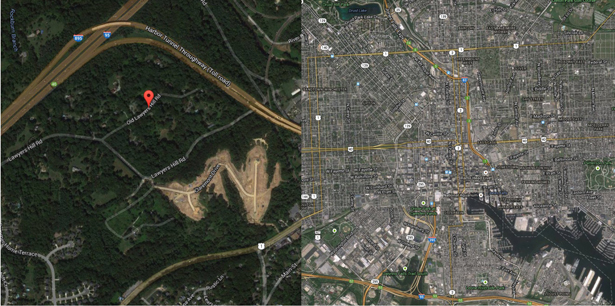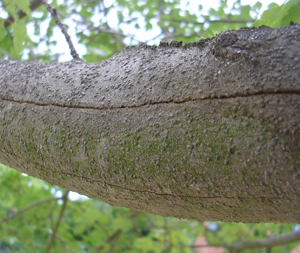Urbanization: Good for Pests, Bad for Trees

Editor’s Note: This is a guest post by Steve Frank, an assistant professor of entomology at NC State.The post first appeared on Frank’s blog, Insect Ecology and Integrated Pest Management.
My wife is from a neighborhood outside Baltimore called Lawyers Hill. This is where, in the 18th century, lawyers (and I assume doctors and other gentlemen) had country houses and could escape the summer heat. Lawyer’s Hill is only three miles from Baltimore but, based on the gentry’s significant investment in houses and land, it must have provided significant relief. So what was (and still is) the difference between Baltimore City and Lawyers Hill? Trees.
Trees cool the environment by shading houses, roads, and sidewalks that absorb heat. If you have ever walked barefoot on pavement in warm weather, you know that pavement is hot and that you scurry from one patch of shade to another. All the heat absorbed by pavement that does not radiate into the soles of your feet radiates into the air. Trees also cool the environment by evaporative cooling called transpiration, in which they release water vapor through their leaves.
Of course there are other reasons cities are hot. Air conditioners, industrial processes, and vehicles all generate heat. An unshaded bus stop is hot but even hotter when the bus is idling next to it.
All this heat can be bad for people. Heat alone poses a risk to human health as does exposure to solar radiation and pollutants that become more concentrated in hot areas. So why don’t cities plant more trees? Many of them do, and try to preserve the trees they have. Unfortunately, arthropod pests are more abundant on urban trees and urban tree survival is low.
In two recent papers, Adam Dale, Ph.D. student extraordinaire, has tackled the questions of why herbivores are more abundant on urban trees and what the consequences are for urban tree health.

Adam works on gloomy scale insects, Melanaspis tenebricosa, an armored scale that feeds on almost every red maple within city limits (go look at the closest red maple, then get back to work).
In one paper, “Urban warming trumps natural enemy regulation of herbivorous pests,” published in Ecological Applications, he shows that urban warming seems to be the primary factor associated with gloomy scale abundance on urban trees. He supports this by identifying an amazing physiological mechanism: scales at warm sites can have three times as many babies as scales at sites just 2.5 degrees cooler!
Adam’s next question was: So what about the trees? Do scale insects and temperature increase plant stress or reduce tree growth? This is what urban foresters need to know if they are going to make management decisions. Why manage scales if the heat kills trees anyway?
Adam’s second paper, “The effects of urban warming on herbivore abundance and street tree condition,” in PLOS ONE shows that both scale insects and heat are associated with poor tree condition. This means trees with scales, and particularly hot trees with scales, are more likely to have dead branches, sparse foliage, and generally look worse than cool trees without scales.
Urbanization is increasing and a new paper in PLOS ONE from Adam Terando and colleagues from NC State and the USGS Southeast Climate Science Center suggests urbanization will expand more (and more quickly) than previously thought. (You can also see this piece on The Rise of Charlanta by Rob Dunn.)
You notice in the image of Lawyer’s Hill (above) that subdivision construction is underway. Each of those new houses will get a lollipop tree, probably a red maple or worse an ornamental plum, but the canopy will never be restored. To conserve trees and their valuable benefits for human and environmental health we need to understand even more about why pests become more abundant on urban trees and which trees should be planted to establish resilient urban forests. It’s clear from Adam Dale’s work that red maples are not a good choice for hot southern cities.
- Categories:


